
It’s the geology that provides the scenery
SHENANDOAH NATIONAL PARK, Va. —The serene setting of Shenandoah is poignant in a surreal manner. The grounds are covered with a blanket of foliage in various shades of green. The inhabitants are not that of human life, but animal life dependent on the multiple arrays of trees and plant life. The air is crisp, especially the morning after a rain when the foliage has drops of dew and the animals come out to play.
The backdrop is the Blue Ridge Mountain chain. The eye first is set on the frontal elements of mountain covered with tall trees flourishing with leaves.
The eye then ventures to the secondary distant mountain elements with a bluish gray tint that is given from water vapor produced from plethora of trees and plant life. The history of how Shenandoah was formed is as majestic as its inhabitants.
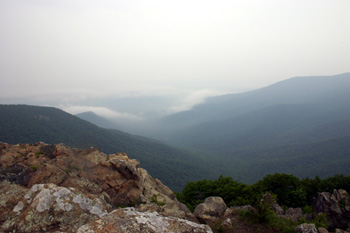 |
The Blue Ridge Mountains are covered with morning clouds (Photo by Tenille Lively). |
Shenandoah was created over one billion years ago in the Precambrian era. Hot granite magma was introduced and then began to cool to form metamorphic rock.
“Shenandoah is unique because it is one of the oldest mountains in the world,” said Joanne Amberson interpretive volunteer of Shenandoah National Park. Amberson has written booklets and pamphlets about the trails of Shenandoah, including Fox Hollow Trail, Frasier Discovery Trail and Short Hikes in Shenandoah National Park.
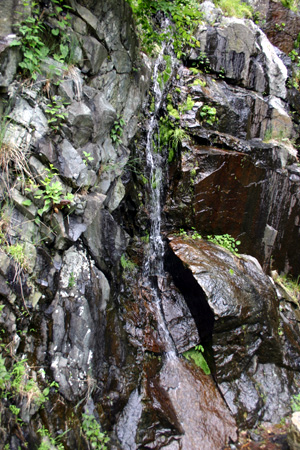 |
| Above and below, rock formations, including waterfalls, that are common along the Skyline Drive of Shenandoah National Park (Photos by Tenille Lively). |
On these trails you can experience astonishing geological formations.
Evidence is present at Old Rag Mountain reaching 3,291 feet, one of the highest points in Shenandoah. Some of the oldest rock formations are evident there. The rounded top of today’s structure is due to natural environmental forces such as wind and rain.
“Natural weathering such as rain, ice action, lichen growing and trees roots growing trough rock formations are some of the natural impacts,” said Sally Herbert, a Shenandoah National Park interpreter.
After cooling of the molten magma, volcanic activity once again became prevalent.
“The volcanic center pouring out caused catatonic formation 600 million years ago,” said Herbert. “Blowing of the lava caused a spatter cone effect.”
Remnants of the volcano are still prevalent just below the Timber Hollow Overlook located by MM 43.3 on Skyline Drive.
“The surrounding area includes cliffs and metamorphic greenstone that is resistant to erosion,” said Herbert.
Another geological wonder was created from continuous lava flow. Cooling of the fresh lava produced the phenomenon columnar jointing, the process of creating polygonal cracks into the surface of the smooth rock.
The Crescent Rock Trail in the Limberlost area by MM 45.6 and Compton Peak by MM 10.4 on Skyline Drive contains many of these geological forms and is fairly easy to hike.
Crescent Rock Trail is smooth and contains an abundance of hemlocks. Compton Peak is rough and rocky but the examples of columnar jointing are an exceptional exhibition of the power of natural elements.
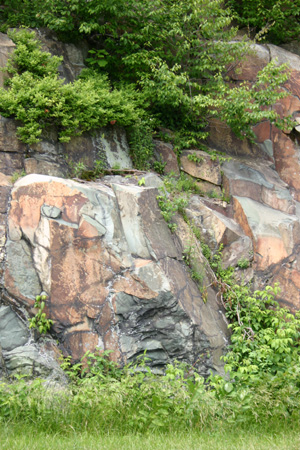 Columnar jointing can also be seen at Little Devils Stairs by MM 20.1 and Franklin Cliffs by MM 49 on Skyline Drive.
Columnar jointing can also be seen at Little Devils Stairs by MM 20.1 and Franklin Cliffs by MM 49 on Skyline Drive.
Basalts, produced by individual lava currents, are evident in columnar jointing.
They were formed 570 million years ago by streaming into the cracks made by cooling of lava. There are many types of ancient basalt forms and they can be seen in various places in the park.
“Crescent Rock displays basalts and granite,” said Warne Nelson supervisor of the Dickey Ridge visitor center. “Mixtures of white and red oak trees that are in the range of 60 to 70 years old surround them.”
Shifting of the Earth’s tectonic plates, or deformation of the Earth’s crust, caused the continental drift. The land was estranged.
On many occurrences the land collided forming the Appalachian Mountains chain. Water from the drifts was enclosed in the mountain chain.
The Shenandoah River is cut into the Blue Ridge Mountains chain creating a pathway for further geological changes by slowly eating away at the rock that flanks it.
It is layered with quartzite, limestone and sandstone that flowed into the river during the separation of the land 600 million years ago.
Waterfalls encourage a change on the geological formation by their constant flow that continues to create new shapes in the rock formations.
Dark Hollow Falls’ picturesque scenery is the most visited located by MM 50.7 on Skyline Drive. It displays three waterfalls.
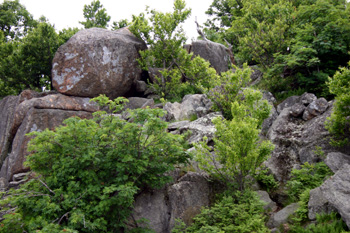 |
Boulders along the Skyline Drive in Shenandoah National Park (Photo by Tenille Lively). |
The falls total 70 feet and flow over rocks and trees. The serene sound of the water flow floods your ears as the flourishing plant and animal life surround you.
The moderate climb takes you away to a tranquil place that only Shenandoah can provide.
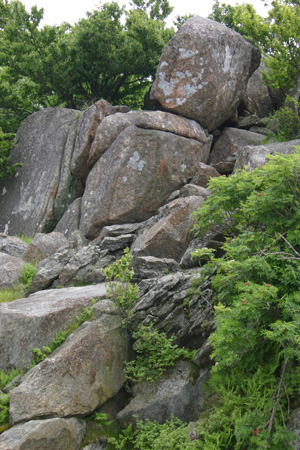 |
| Large boulders are piled on top of each other like toy blocks through the forces of nature (Photo by Tenille Lively). |
For the more experienced hiker, White Oak Canyon located by MM 42.6 on Skyline Drive is a strenuous climb that displays six waterfalls totaling 350 feet in length.
The beauty and majesty of the falls that eventually combine into one encompasses a rocky path surrounded by blossoming trees and a view of historic Limberlost.
Shenandoah is forever changing. The mountain chain that was thought to once be the size of the Himalayas is now the rolling mountain chain of today. Natural elements still shape the region.
In June of 1995 during Madison County landslide, 30 inches of rain fell in 16 hours causing rock slides and carving the mountain range into a new shape.
The flood is termed the “1,000 year” rainstorm because an occurrence of this magnitude that shapes the face of geology is rarely witnessed due to the slow and steady changes in formations.
Shenandoah is one of the oldest geological formations in the world.
The geology tells of numerous historical occurrences on the surface and hidden underneath years of transformation. The park offers geological tours for all interests.
“The geology of Shenandoah is a fascinating story and is told in many ways,” said Amberson.
One and a half to two million people visit the park annually to experience the wonders that Shenandoah provides.
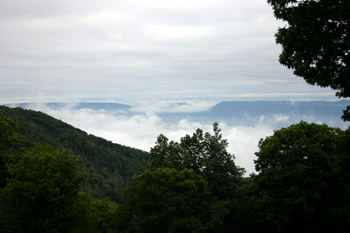 |
The cloud-covered Shenandoah Valley lies between ridges of the mountains (Photo by Tenille Lively). |
Check out the park’s rock formations:
| BEST LOCATIONS FOR VIEWING | MILEMARKER ALONG SKYLINE DRIVE |
DIFFICULTY TO REACH |
| COLUMNAL JOINTING | ||
| Crescent Rock Trail | MM 45.6 | fairly easy |
| Compton Peak | MM 10.4 | fairly easy |
| Little Devil Stairs | MM 20.1 | strenuous |
| Franklin Cliffs | MM 49 | overlook |
| WATERFALLS | ||
| Dark Hollow Falls | MM 50.7 | moderate |
| South River Falls . | MM 62.8 | moderate |
| Whiteoak Canyon | MM.42.6 | strenuous |
| Overall Run | MM 22.1 | moderate |
| GRANITE | ||
| Old Rag Mountain | MM 45.6 | |
| SEDIMENTARY ROCK FORMATIONS (SUCH AS QUARTZITE) |
||
| Hawksbill Mountain Summit | MM 46.7 | moderate |
| Black Rock Summit | MM 84.8 | easy |
| Compton Peak | MM 10.4 | fairly easy |
| NEWER FORMATIONS | ||
| Whiteoak Canyon | MM 42.6 | moderate |
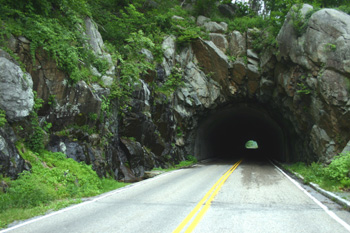 |
Marys Rock Tunnel was cut through 600 feet of rock in 1932 as part of Skyline Drive (Photo by Tenille Lively). |

Comments are Closed